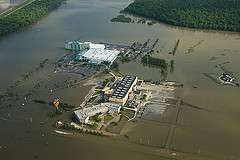Recent weather, disasters show importance of emergency readiness

(PhysOrg.com) -- With an earthquake in Philadelphia, tornadoes in Massachusetts and elsewhere, wildfires in Arizona and massive flooding in the Midwest, spring 2011 has been marked by rare disasters and extreme weather. As June ushers in the hurricane season, an extension specialist in Penn State's College of Agricultural Sciences said people should prepare themselves for the next outbreak of the unexpected.
From Mississippi to North Dakota, recent natural disasters have struck at unusual times, in unusual locations or with unusual severity, said David Filson, Penn State Extension state program leader for emergency readiness. He said the nation is seeing an atypical number of natural mishaps and problems this spring, and no one is sure why this is occurring.
"Obviously, we're seeing a change in the kinds and severity of disasters all across the United States," Filson said. "For Pennsylvania, most of the disasters and emergencies that we need to be prepared for primarily are weather-related."
"We've had numerous tornadoes touch down this spring -- something we rarely see," he said. "Flooding is the most common type, but we're seeing more occurrences of high wind and tornado-related accidents and emergencies."
Filson said the June start of hurricane season means people should be prepared for flooding. "Wind storms can cause associated damage and secondary effects, such as power outages, road and bridge closures, and so on," he said. "So it's important for residents to understand the range of disasters that can affect their homes, communities and daily lives."
Penn State Extension offers extensive educational materials for people preparing for or recovering from disasters, he said.
"We're not an emergency-response, first-on-the-scene agency, but we have a variety of resources that we can share with homeowners to help them better prepare. In emergency situations, an ounce of prevention can be worth more than a pound of cure."
He said a wealth of information for individuals, families and businesses is available online at the Pennsylvania Extension Disaster Education Network at extension.psu.edu/prepare. Resources also are available from "Ready" (www.ready.gov/), a federal website sponsored by the U.S. Office of Homeland Security, the Federal Emergency Management Agency, the American Red Cross and others.
Filson said there are three essential steps to emergency preparation:
-- Assemble a "go bag" or kit. An emergency kit or "go bag" can serve several functions if you're looking to leave your home. "If you need to leave quickly and have limited warning, it's best to have everything prepared in one location so that you can grab it and have all the things you need," he said.
"You should take with you everything you need to stay on your own for about three days: food, water, a battery- or hand-powered radio with weather band, prescription medicines, first aid kit and more. There are a number of other important things to take, including family documents such as insurance policies, bank account records, driver's licenses and such, stored in waterproof containers."
-- Make and communicate a family disaster plan. "Your family may be at school or at work, and it's very important for everyone to know what the plan is if you're separated and family members can't return home," he said. "Is there a designated gathering point or a predetermined emergency shelter? Identify a family member or friend living outside of the area to be a communication support person for when cell phones or land lines may not be available and you want to communicate when you are separated."
-- Stay informed on potential and approaching threats. Although tornadoes usually are associated with the Midwest, they also can strike in Pennsylvania. Filson said it's important for residents to understand and be watchful for the kinds of disasters that can affect where they live.
"Spring flooding, high winds and winter storms are typical for this region during specific time periods," he said. "If you've just moved into the area, for instance, and you're not sure of the kinds of disasters that you can expect, contact your local emergency management office."
For agricultural producers, Penn State Extension sponsors ReadyAG (www.readyag.psu.edu), a collaborative project that draws on the expertise of extension professionals from several land-grant universities to offer a set of disaster-planning and continuity-of-operations worksheets for each of the major agricultural commodities.
"ReadyAG focuses on disaster and defense preparedness for production agriculture, helping ag business owners take steps to be better prepared for possible disasters," Filson said. "We provide a checklist of questions for livestock, dairy, fruit and vegetable producers to be better prepared and have continuity of operations following a natural disaster.
We're primarily interested in the safety and security of human life, but we recognize the importance of agriculture in Pennsylvania," he said.
Provided by Pennsylvania State University















